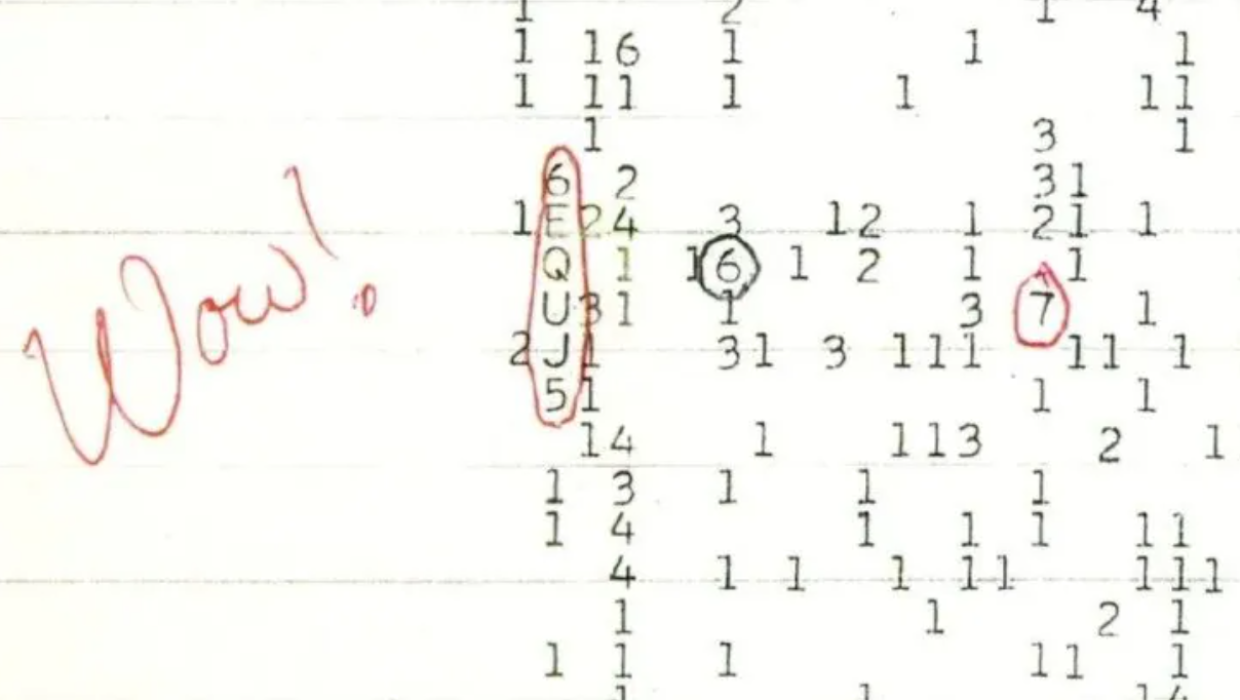Science
Scientists Identify Natural Source Behind 1977 Alien Radio Signal

A radio signal detected in 1977, long considered a potential sign of extraterrestrial life, has been attributed to a natural source, according to a recent study by scientists at the University of California, Berkeley. The signal, famously dubbed the “Wow! signal” due to the enthusiastic notation made by astronomer Jerry R. Ehman, has intrigued researchers for decades.
Initially recorded at the Big Ear Observatory in Ohio, the Wow! signal was a strong burst of radio waves that lasted 72 seconds. It was so distinct that it prompted scientists to speculate about its origin, with many suggesting it could be a communication from an alien civilization. After years of study, new findings suggest that the signal likely originates from a natural astrophysical source.
Research led by astronomers from the Search for Extraterrestrial Intelligence (SETI) has focused on identifying the conditions that could have produced the Wow! signal. In their analysis, they examined various cosmic phenomena. Their work indicates that certain types of stars, specifically a class known as “pulsars,” can emit signals resembling the Wow! signal under particular conditions.
Decoding the Mystery of the Wow! Signal
The study points to a specific type of star, a “pulsating star” that can create similar radio emissions. These pulsating stars, much like pulsars, have a rapid rotation and emit beams of radiation that can be detected as radio signals on Earth. The team used advanced software models to replicate the conditions that could generate such signals, concluding that the Wow! signal fits these patterns.
The implications of this research are significant for the field of astronomy. For years, scientists have been divided over whether the Wow! signal was a genuine indication of extraterrestrial intelligence or a mere cosmic coincidence. With this new evidence, the debate may shift towards understanding these natural phenomena rather than searching for alien communications.
The team’s findings were published in the journal “Astrophysical Journal Letters” on September 30, 2023. This study not only sheds light on the nature of the Wow! signal but also enhances our understanding of radio emissions from various celestial bodies.
Continuing the Search for Extraterrestrial Life
Despite this revelation, the quest for extraterrestrial life continues unabated. Scientists at SETI and other institutions remain committed to exploring the universe for signals that might indicate intelligent life. The Wow! signal, while likely not an alien communication, has reaffirmed the importance of ongoing research and technological advancements in the field.
As technology continues to evolve, new methods of detecting and analyzing cosmic signals will enhance our ability to decipher the mysteries of the universe. The ongoing exploration of radio waves and their sources could lead to further discoveries, perhaps even unlocking new secrets about our universe.
In conclusion, while the Wow! signal has been shown to originate from a natural source, the curiosity it sparked continues to inspire a generation of astronomers. With each new discovery, humanity takes another step towards understanding its place in the cosmos.
-

 World4 months ago
World4 months agoTest Your Knowledge: Take the Herald’s Afternoon Quiz Today
-

 Sports4 months ago
Sports4 months agoPM Faces Backlash from Fans During Netball Trophy Ceremony
-

 Lifestyle4 months ago
Lifestyle4 months agoDunedin Designers Win Top Award at Hokonui Fashion Event
-

 Entertainment4 months ago
Entertainment4 months agoExperience the Excitement of ‘Chief of War’ in Oʻahu
-

 Sports4 months ago
Sports4 months agoLiam Lawson Launches New Era for Racing Bulls with Strong Start
-

 World5 months ago
World5 months agoCoalition Forms to Preserve Māori Wards in Hawke’s Bay
-

 Health4 months ago
Health4 months agoWalking Faster Offers Major Health Benefits for Older Adults
-

 Lifestyle4 months ago
Lifestyle4 months agoDisney Fan Reveals Dress Code Tips for Park Visitors
-

 Politics4 months ago
Politics4 months agoScots Rally with Humor and Music to Protest Trump’s Visit
-

 Top Stories5 months ago
Top Stories5 months agoUK and India Finalize Trade Deal to Boost Economic Ties
-

 Health2 months ago
Health2 months agoRadio Host Jay-Jay Feeney’s Partner Secures Visa to Stay in NZ
-

 World5 months ago
World5 months agoHuntly Begins Water Pipe Flushing to Resolve Brown Water Issue









